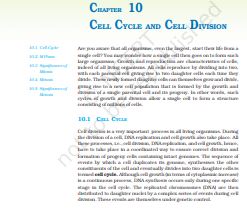‘NCERT Solutions for Class 11 Biology Chapter 10 Cell Cycle and Division’ PDF Quick download link is given at the bottom of this article. You can see the PDF demo, size of the PDF, page numbers, and direct download Free PDF of ‘Ncert Class 11 Biology Chapter 10 Exercise Solution’ using the download button.
Cell Cycle and Division NCERT Textbook With Solutions Book PDF Free Download

Chapter 10: Cell Cycle and Division
10.1 CELL CYCLE
Cell division is a very important process in all living organisms. During the division of a cell, DNA replication and cell growth also take place.
All these processes, i.e., cell division, DNA replication, and cell growth, hence, have to take place in a coordinated way to ensure the correct division and formation of progeny cells containing intact genomes.
The sequence of events by which a cell duplicates its genome synthesizes the other
constituents of the cell and eventually divides into two daughter cells is termed the cell cycle.
Although cell growth (in terms of cytoplasmic increase) is a continuous process, DNA synthesis occurs only during one specific stage in the cell cycle.
The replicated chromosomes (DNA) are then distributed to daughter nuclei by a complex series of events during cell division. These events are themselves under genetic control.
10.1.1 Phases of Cell Cycle
A typical eukaryotic cell cycle is illustrated by human cells in culture. These cells divide once
approximately every 24 hours (Figure 10.1).
However, this duration of the cell cycle can vary
from organism to organism and also from cell type to cell type. Yeast, for example, can progress
through the cell cycle in only about 90 minutes.
10.2 M PHASE
This is the most dramatic period of the cell cycle, involving a major reorganization of virtually all components of the cell. Since the number of chromosomes in the parent and progeny cells are the same, it is also called equational division.
Though for convenience mitosis has been divided into four stages of nuclear division, it is very essential to understand that cell division is a progressive process and very clear-cut lines cannot be drawn between various stages.
10.2.1 Prophase
Prophase which is the first stage of mitosis follows the S and G2 phases of interphase. In the S and G2 phases, the new DNA molecules formed are not distinct but intertwined. Prophase is marked by the initiation of condensation of chromosomal material.
The chromosomal material becomes untangled during the process of chromatin condensation (Figure 10.2 a). The centriole, which had undergone duplication during the S phase of interphase, now begins to move towards opposite poles of the cell.
The completion of the prophase can thus be marked by the following characteristic events:
l Chromosomal material condenses to form compact mitotic chromosomes.
Chromosomes are seen to be composed of two chromatids attached together at the centromere.
l Initiation of the assembly of the mitotic spindle, the microtubules, and the proteinaceous components of the cell cytoplasm help in the process.
| Author | NCERT |
| Language | English |
| No. of Pages | 11 |
| PDF Size | 2 MB |
| Category | Biology |
| Source/Credits | ncert.nic.in |
NCERT Solutions Class 11 Biology Chapter 10 Cell Cycle and Division
1. What is the average cell cycle span for a mammalian cell?
Solution:
The average cell cycle span for a mammalian cell is 24 hours.
2. Distinguish cytokinesis from karyokinesis.
Solution:
| Cytokinesis | Karyokinesis |
| It is the cell division of the cytoplasm that occurs during the M phase of the cell cycle. | It is the separation of daughter chromosomes corresponding to M phase of cell cycle |
3. Describe the events taking place during interphase.
Solution:
Events taking place during the interphase are as follows:
- G1 phase (Gap 1) – During this stage, the cell is metabolically active. It grows and prepares the DNA to replicate.
- S phase (Synthesis) – During this stage, the synthesis of DNA takes place. The DNA quantity doubles whereas the number of chromosomes remains unchanged
- G2 phase (Gap 2) – During this phase, the cell advances to grow and prepare itself for division. It is during this stage that the RNA and proteins that are required for mitosis are generated.
4. What is the Go (quiescent phase) of the cell cycle?
Solution:
In adult animals, some cells will not exhibit cell division, and many other cells occasionally divide when there is a need to replace cells that have been lost because of injury or cell death.
These cells exit the G1 phase to enter the inactive stage of the cell cycle called G0 phase. Cells in G0 phase do not proliferate unless called on to do so. Hence, the cells in this phase tend to become inactive, stop dividing and become specialized through the differentiation process.
5. Why is mitosis called equational division?
Solution:
Mitosis is called equational division because the number of chromosomes in the parent and progeny cells is the same.
NCERT Class 11 Biology Textbook Chapter 10 Cell Cycle and Division With Answer PDF Free Download
